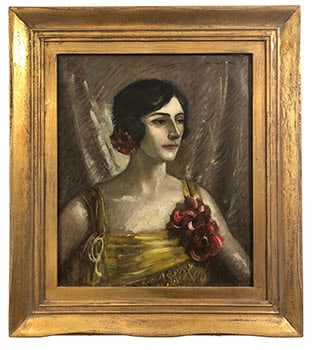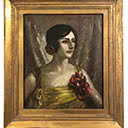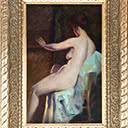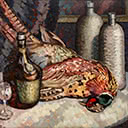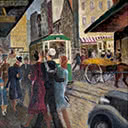Phyllis Constance Cavendish
60.2 x 50.7 cm
PROVENANCE
Paul & Kerry Barber Collection
Sir Ivor Richardson Art Collection,
Dunbar Sloane, 22/03/2006
McIntyre met the 22-year actress Phyllis Constance Cavendish and she became the subject of many portraits in both oil and watercolour. Writing to his father on 4/5/6 December 1912, McIntyre states, "I did the best work I have ever done so far, from her. I like to go outside the usual run of professional models, of which there are hundreds and hundreds in London - and get people of more normal type and who do not live in the atmosphere of studios all the time. It is more interesting to have a breath of the outside world come along with different interests and information to impart. These stage folk who I have had are very helpful to me in that way' Alexander Bassano (1829 - 1913), a leading royal and high society portrait photographer in Victorian London made photographic portraits of Phyllis Cavendish, it is clear that her bone structure, long neck, full lips, dark eyebrows, wavy hair and small defined nose are all conveyed in Raymond McIntyre's portraits of her.
Raymond McIntyre was an emigre New Zealand artist whose departure was an enormous loss to painting in this country. Born in Christchurch he studied with Petrus van der Velden and attended evening classes organised by the Canterbury College School of Art. In 1905 he joined a sketch club where he met Sydney Lough Thompson who had recently returned from four years study in Europe. From 1906 - 08 McIntyre shared a studio in Cathedral Square with Leonard Booth who described him as an enthusiastic disciple of Whistler.
In 1906 - 07 McIntyre was able to observe for himself the new techniques of impressionism when twenty works by English Art Club members were shown at the New Zealand International Exhibition in Christchurch. These were to be enormously influential in forming McIntyre's modern style of painting, a factor which did not always endear him to the art establishment in New Zealand. Consequently, in 1909 at the age of thirty, he left for England where he began an intensive period of study with such noted artists as Walter Sickert and William Nicholson.
Diverse work included street scenes, a subject he shared with the Camden Town Group, and from 1920 he began to paint rivers and parks. McIntyre was also a talented musician, writer, printmaker, theatre and music critic. For some years he was art critic for Architectural Review. He was a Christian Scientist from 1907 and in 1933 refused an operation for a hernia. The resulting infection caused his death which could have been prevented if he had permitted medical treatment.
This work most likely dates from the later period of the Cavendish series, and probably the artist's last portrait of her, due to the fuller figure of the model and the employment of more representative details including the atmosphere and recession of the background, a shift away from the Art Nouveau characteristics that are predominant in earlier portraits of the subject.

